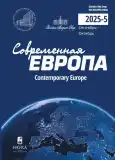Italian Personalist Parties: Features and Reasons for Emergence
- Авторлар: Mukhametov R.S1
-
Мекемелер:
- Ural Federal University named after the First President of Russia B.N. Yeltsin
- Шығарылым: № 5 (133) (2025)
- Беттер: 172-181
- Бөлім: PARTIES AND POLITICAL MOVEMENTS
- URL: https://rjsvd.com/0201-7083/article/view/695695
- DOI: https://doi.org/10.31857/S0201708325050146
- ID: 695695
Дәйексөз келтіру
Аннотация
The article highlights that the personalization of politics as one of new trends in the development of European political parties. The author argues that this is reflected in the emergence of personalist parties in the EU member states. It is shown that Italy is the leader in the number of such parties. The overall objective of the article is to identify the main features of these parties, as well as to show the role of the majority electoral system as an explanation for their emergence. Much attention is paid to the conceptual definition of personalist parties. It has been found that such parties are usually led by a dominant leader who determines the direction of the party’s development; and a poorly structured organization, as well as the absence of intraparty democracy. Based on the method of comparative analysis of specific cases, the author identified a number of features of personalist parties in Italy related to their ideology (populism and euro- scepticism), the origin of the parties, and the status of the founders. The article discusses the reasons for the emergence of personalist parties in Italy. The author focuses on the high role of the introduction of the majority system in parliamentary elections (electoral reform in 1993) as an explanation for the creation of these parties. The main cause-and-effect mechanism lies in the specifics of personality-oriented electoral systems: voting for individual candidates, the use of single-mandate constituencies, the emphasis during the election campaign on the candidate’s personality, greater autonomy of politicians from parties, etc.
Авторлар туралы
R. Mukhametov
Ural Federal University named after the First President of Russia B.N. Yeltsin
Email: muhametov.ru@gmail.ru
Candidate of Sciences (Politics) Yekaterinburg, Russia
Әдебиет тізімі
- Алексеенкова Е.С. (2023) Политический процесс в современной Италии: антиполитика и популизм эпохи Второй республики. Институт Европы РАН, Москва. 218 с.
- Артамонова Ю.Д., Демчук В.А. (2021) Современная персонализация политики: новые подходы к анализу. Полис. Политические исследования. № 6. С. 108–121. doi: 10.17976/jpps/2021.06.08
- Кукарцева М.А. (2017) Эффект персонализации современной политики. Вестник РГГУ. Серия «Философия. Социология. Искусствоведение». № 4‒2. С. 239–251.
- Любарев А.Е. (2016) Избирательные системы: российский и мировой опыт. РОО «Либеральная миссия»; Новое литературное обозрение, Москва. 632 с.
- Макаренко Б.И., Петров И.И. (2023) Динамика политического спектра европейских партийных систем (1990‒2021). Полис. Политические исследования. № 1. С. 11–28. doi: 10.17976/jpps/2023.01.03
- Маслова Е.А., Шебалина Е.О. (2021) Трансформация партийно-политической системы Италии. Современная Европа. № 2. С. 111–123. doi: 10.15211/soveurope22021111123
- Шибкова М.О. (2018) Возникновение и эволюция партийного евроскептицизма как феномена политической жизни Италии. Вестник РУДН. Серия: Международные отношения. № 1. С. 19–32.
- Calice M. (2015) The personal party: an analytical framework. Italian Political Science Review/Rivista Italiana di Scienza Politica. Vol. 45. No. 3. Р. 301–315.
- Cohen M., Karol D., Noel H., Zaller J. (2009) The Party Decides: Presidential Nominations Before and After Reform. University of Chicago Press, Chicago, USA. 416 р.
- Frantz E., Kendall-Taylor A., Li J., Wright J. (2022) Personalist ruling parties in democracies. Democratization. Vol. 29. No. 5. Р. 918–938. doi: 10.1080/13510347.2021.2019711
- Gunther R., Diamond L. (2003) Species of political parties: A new typology. Party politics. Vol. 9. No. 2. P. 167–199.
- Kostadinova T., Levitt B. (2014) Toward a Theory of Personalist Parties: Concept Formation and Theory Building. Politics & Policy. Vol. 42. No. 4. Р. 490–512. doi: 10.1111/polp.12081
- Levitt B., Kostadinova T. (2014) Personalist Parties in the Third Wave of Democratization: A Comparative Analysis of Peru and Bulgaria. Politics & Policy. Vol. 42. No. 4. Р. 513–547. doi: 10.1111/polp.12084
- Marino В., Martocchia Diodati N., Verzichelli L. (2022) The personalization of party politics in Western Europe (1985–2016): evidence from an expert survey. Acta Politica. Vol. 57. No. 1. Р. 571–596. doi: 10.1057/s41269-021-00210-x
- Musella F. (2020) The personalization of Italian political parties in three acts. Contemporary Italian Politics. Vol. 12. No. 4. Р. 411–424. doi: 10.1080/23248823.2020.1838870
- Norris P. (2019) Varieties of populist parties. Philosophy & Social Criticism. Vol. 45. No. 9– 10. Р. 981–1012. doi: 10.1177/0191453719872279
- Pasquino G. (2014) Italy: The Triumph of Personalist Parties. Politics & Policy. Vol. 42. No. 4. Р. 548–566. doi: 10.1111/polp.12079
- Rahat G. (2022) Party Types in the Age of Personalized Politics. Perspectives on Politics. Vol. 22. No. 1. Р. 1–16. doi: 10.1017/S1537592722000366
- Seisselberg J. (1996) Conditions of success and political problems of a “media mediated personality party”: The case of Forza Italia. West European Politics. Vol. 19. No. 4. Р. 715–743.
- Shefter M. (1993) Political Parties and the State. Princeton University Press, Princeton, USA. 316 р.
Қосымша файлдар









